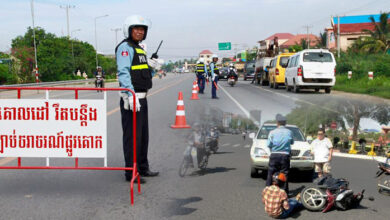ច្បាប់ចរាចរណ៍ ថ្មីនឹងដាក់អនុវត្តនៅដើមឆ្នាំ ២០១៦ ដោយការផាក់ពិន័យគុណ ៥ដង
សារព័ត៌មាន Cambodia News/
ភ្នំពេញ (១០ កក្កដា ២០១៥) ៖ ការអនុវត្តច្បាប់ចរាចរណ៍ផ្លូវគោកថ្មីទាក់ទងនឹងការផាកពិន័យអ្នកមិនពាក់មួកសុវត្ថិភាព និងពាក់ខ្សែក្រវាត់ នឹងត្រូវចាប់ផ្តើមអនុវត្តនៅថ្ងៃទី ១ មករា ឆ្នាំ ២០១៦ នេះតទៅដោយការពិន័យគុណនឹង ៥ ដងលើសពីមុន។
ការមិនពាក់មួកសុវត្ថិភាពទាំងអ្នកបើកបរ និងអ្នករួមដំណើរដោយទោចក្រយានយន្តនឹងត្រូវនគរបាលចរាចរណ៍ពិន័យចំនួន ១៥០០០ រៀល រីឯអ្នកបើកបររថយន្តធុនស្រាលមិនពាក់ខ្សែក្រវាត់ត្រូវពិន័យ ២៥០០០ រៀលហើយអ្នកបើកបរយានយន្តធុនធ្ងន់ត្រូវពិន័យចំនួន ៥០០០០ រៀល។
នេះបើតាមសេចក្តីព្រាងអនុក្រឹត្យរបស់រាជរដ្ឋាភិបាលស្តីពី «ការពិន័យអន្តរការណ៍ចំពោះអំពើល្មើសនឹងច្បាប់ស្តីពីចរាចរណ៍ផ្លូវគោក» ដែលទទួលបានពីម្សិលមិញ។
សេចក្តីព្រាងអនុក្រឹត្យដែលមាន ៤ មាត្រា និង ១៣ ជំពូកក៏បានសរសេរនូវចំណុចជាច្រើនទាក់ទងនឹងការផាកពិន័យនូវទឹកប្រាក់ដូចគ្នាចំពោះអ្នកប្រើប្រាស់ផ្លូវថ្នល់ដែលល្មើសច្បាប់រួមមានអ្នកបើកបរមិនយកជាប់ខ្លួននូវប័ណ្ណបើកបរ ប័ណ្ណសម្គាល់យានយន្តអ្នកបើកបរដាក់កុមារក្រោម ១០ ឆ្នាំ អង្គុយនៅកៅអីខាងមុខនៃរថយន្ត អ្នកបើកបរបើកយានយន្តដោយកុងទ័រល្បឿនមិនដំណើរការ និងអ្នកបើកបរយានយន្តប្រើប្រាស់ទូរស័ព្ទគ្មានឧបករណ៍សំឡេងភ្ជាប់ទំនាក់ទំនងជាដើម។
ការបើកបរបង្ហោះ រេចុះឡើង ឆាប ឬកៀរ នឹងត្រូវផាកពិន័យ ២០០០០ រៀលចំពោះទោចក្រយានយន្ត ផាក ៤០០០០ រៀលចំពោះយានយន្តធុនស្រាល និង ៧៥០០០ រៀលចំពោះយានយន្តធុនធ្ងន់។ ចំណុចនេះក៏ត្រូវអនុវត្តចំពោះការបើកយានយន្តដែលម៉ាស៊ីនបញ្ចេញសំឡេងខ្លាំង ឬផ្សែងច្រើនខុសបទដ្ឋាន បើកបរយានយន្តដែលគ្មានដំណើរការនៃផ្លិតជូតកញ្ចក់មុខផងដែរ៕



